Analyzing Integrated Care: A Breast Cancer Patient's Journey
VerifiedAdded on 2023/06/10
|24
|7115
|494
Case Study
AI Summary
This nursing assignment presents a case study analyzing the journey of a 49-year-old woman diagnosed with breast cancer, highlighting the psychological, emotional, physical, and practical challenges she faced throughout diagnosis, treatment, and recovery. The case study details her treatment plan, including pre-operative chemotherapy, mastectomy, and post-operative chemotherapy and radiation therapy, while exploring the side effects and impact on her body image and mental health. The analysis also discusses the financial burdens and access to care challenges, along with the role of the UK National Health Service (NHS) in providing integrated cancer care. The assignment emphasizes the importance of personalized care and support planning in meeting the complex needs of cancer patients and improving their overall experience, while mentioning the role of NHS cancer plan 2000.

Running head: NURSING ASSIGNMENT
Nursing assignment
Name of the Student
Name of the University
Author not
Nursing assignment
Name of the Student
Name of the University
Author not
Paraphrase This Document
Need a fresh take? Get an instant paraphrase of this document with our AI Paraphraser
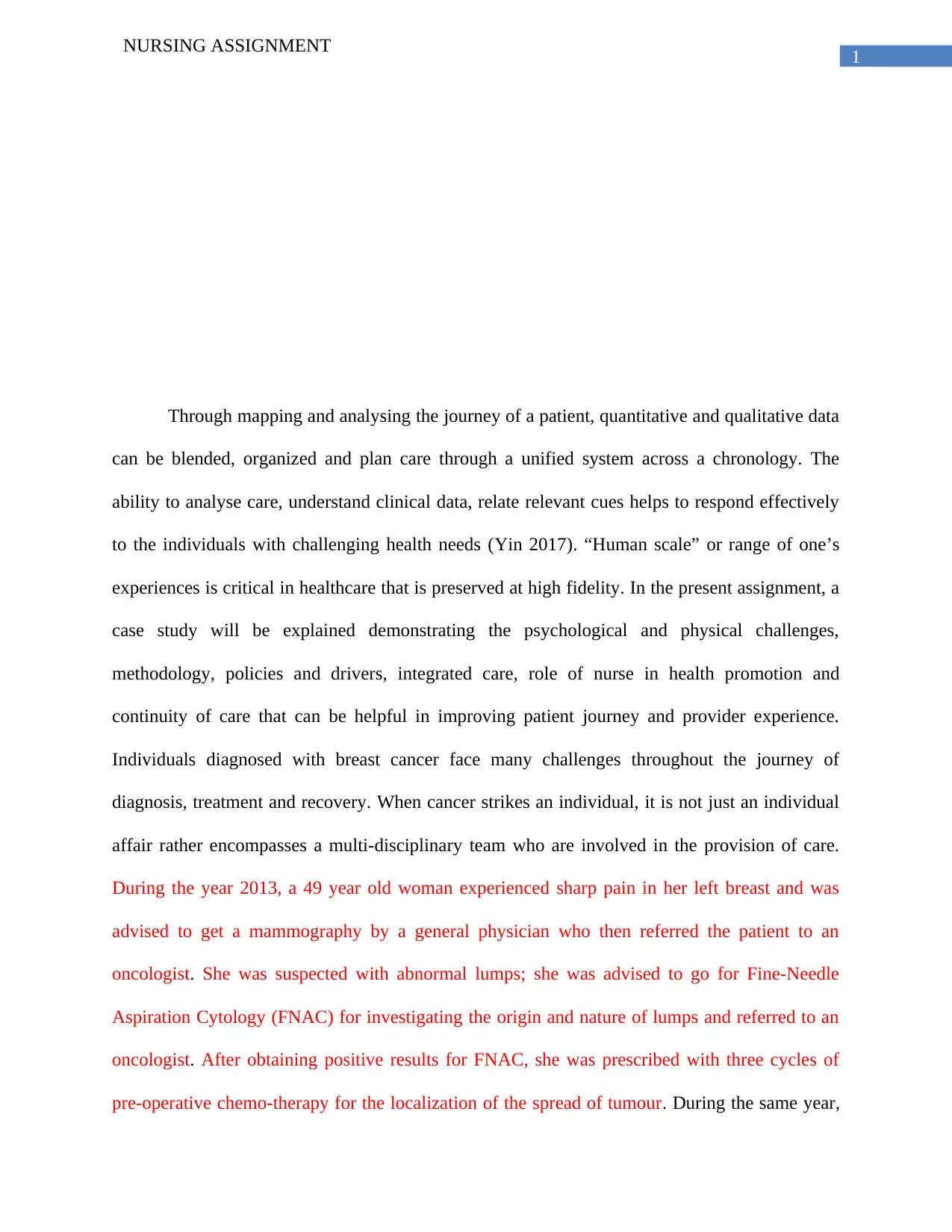
1
NURSING ASSIGNMENT
Through mapping and analysing the journey of a patient, quantitative and qualitative data
can be blended, organized and plan care through a unified system across a chronology. The
ability to analyse care, understand clinical data, relate relevant cues helps to respond effectively
to the individuals with challenging health needs (Yin 2017). “Human scale” or range of one’s
experiences is critical in healthcare that is preserved at high fidelity. In the present assignment, a
case study will be explained demonstrating the psychological and physical challenges,
methodology, policies and drivers, integrated care, role of nurse in health promotion and
continuity of care that can be helpful in improving patient journey and provider experience.
Individuals diagnosed with breast cancer face many challenges throughout the journey of
diagnosis, treatment and recovery. When cancer strikes an individual, it is not just an individual
affair rather encompasses a multi-disciplinary team who are involved in the provision of care.
During the year 2013, a 49 year old woman experienced sharp pain in her left breast and was
advised to get a mammography by a general physician who then referred the patient to an
oncologist. She was suspected with abnormal lumps; she was advised to go for Fine-Needle
Aspiration Cytology (FNAC) for investigating the origin and nature of lumps and referred to an
oncologist. After obtaining positive results for FNAC, she was prescribed with three cycles of
pre-operative chemo-therapy for the localization of the spread of tumour. During the same year,
NURSING ASSIGNMENT
Through mapping and analysing the journey of a patient, quantitative and qualitative data
can be blended, organized and plan care through a unified system across a chronology. The
ability to analyse care, understand clinical data, relate relevant cues helps to respond effectively
to the individuals with challenging health needs (Yin 2017). “Human scale” or range of one’s
experiences is critical in healthcare that is preserved at high fidelity. In the present assignment, a
case study will be explained demonstrating the psychological and physical challenges,
methodology, policies and drivers, integrated care, role of nurse in health promotion and
continuity of care that can be helpful in improving patient journey and provider experience.
Individuals diagnosed with breast cancer face many challenges throughout the journey of
diagnosis, treatment and recovery. When cancer strikes an individual, it is not just an individual
affair rather encompasses a multi-disciplinary team who are involved in the provision of care.
During the year 2013, a 49 year old woman experienced sharp pain in her left breast and was
advised to get a mammography by a general physician who then referred the patient to an
oncologist. She was suspected with abnormal lumps; she was advised to go for Fine-Needle
Aspiration Cytology (FNAC) for investigating the origin and nature of lumps and referred to an
oncologist. After obtaining positive results for FNAC, she was prescribed with three cycles of
pre-operative chemo-therapy for the localization of the spread of tumour. During the same year,
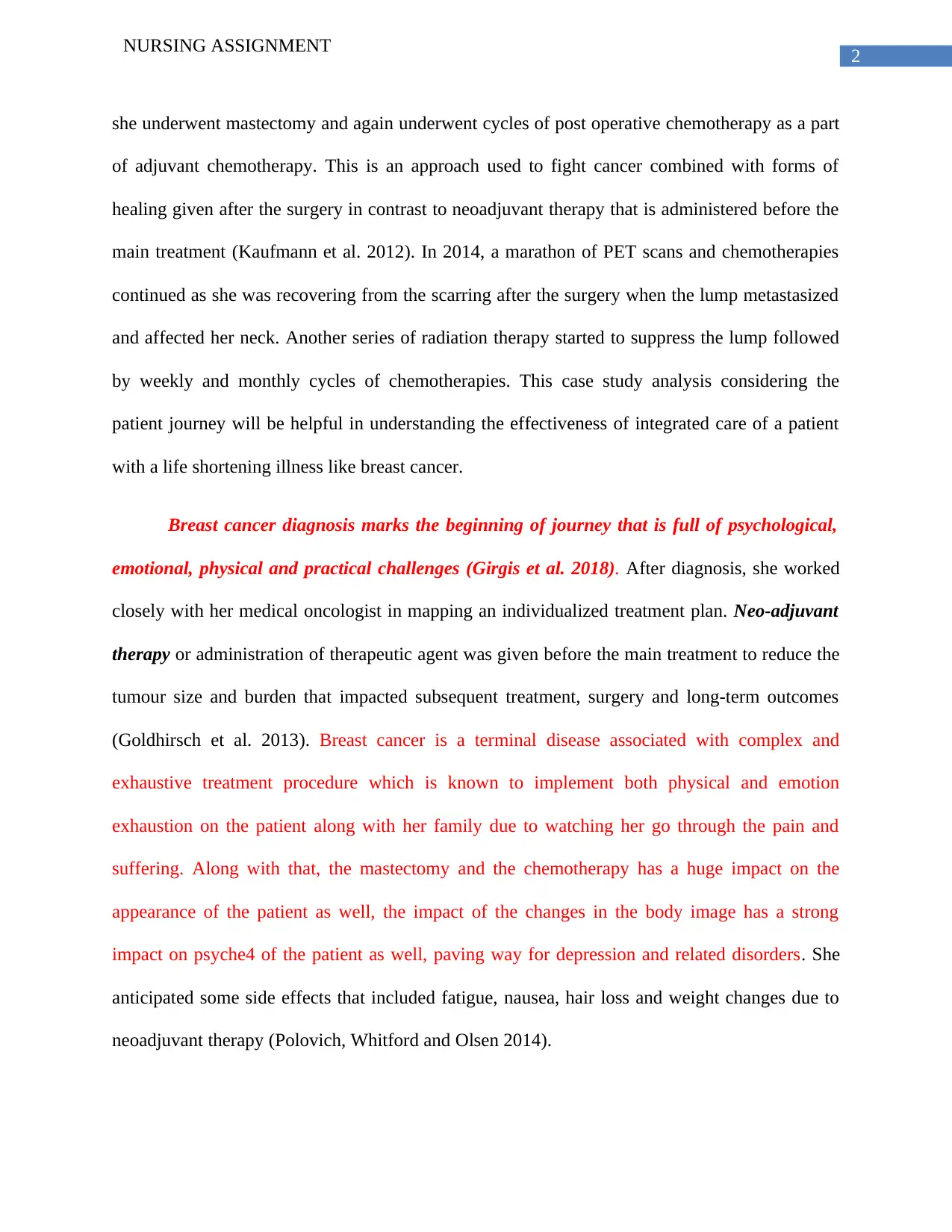
2
NURSING ASSIGNMENT
she underwent mastectomy and again underwent cycles of post operative chemotherapy as a part
of adjuvant chemotherapy. This is an approach used to fight cancer combined with forms of
healing given after the surgery in contrast to neoadjuvant therapy that is administered before the
main treatment (Kaufmann et al. 2012). In 2014, a marathon of PET scans and chemotherapies
continued as she was recovering from the scarring after the surgery when the lump metastasized
and affected her neck. Another series of radiation therapy started to suppress the lump followed
by weekly and monthly cycles of chemotherapies. This case study analysis considering the
patient journey will be helpful in understanding the effectiveness of integrated care of a patient
with a life shortening illness like breast cancer.
Breast cancer diagnosis marks the beginning of journey that is full of psychological,
emotional, physical and practical challenges (Girgis et al. 2018). After diagnosis, she worked
closely with her medical oncologist in mapping an individualized treatment plan. Neo-adjuvant
therapy or administration of therapeutic agent was given before the main treatment to reduce the
tumour size and burden that impacted subsequent treatment, surgery and long-term outcomes
(Goldhirsch et al. 2013). Breast cancer is a terminal disease associated with complex and
exhaustive treatment procedure which is known to implement both physical and emotion
exhaustion on the patient along with her family due to watching her go through the pain and
suffering. Along with that, the mastectomy and the chemotherapy has a huge impact on the
appearance of the patient as well, the impact of the changes in the body image has a strong
impact on psyche4 of the patient as well, paving way for depression and related disorders. She
anticipated some side effects that included fatigue, nausea, hair loss and weight changes due to
neoadjuvant therapy (Polovich, Whitford and Olsen 2014).
NURSING ASSIGNMENT
she underwent mastectomy and again underwent cycles of post operative chemotherapy as a part
of adjuvant chemotherapy. This is an approach used to fight cancer combined with forms of
healing given after the surgery in contrast to neoadjuvant therapy that is administered before the
main treatment (Kaufmann et al. 2012). In 2014, a marathon of PET scans and chemotherapies
continued as she was recovering from the scarring after the surgery when the lump metastasized
and affected her neck. Another series of radiation therapy started to suppress the lump followed
by weekly and monthly cycles of chemotherapies. This case study analysis considering the
patient journey will be helpful in understanding the effectiveness of integrated care of a patient
with a life shortening illness like breast cancer.
Breast cancer diagnosis marks the beginning of journey that is full of psychological,
emotional, physical and practical challenges (Girgis et al. 2018). After diagnosis, she worked
closely with her medical oncologist in mapping an individualized treatment plan. Neo-adjuvant
therapy or administration of therapeutic agent was given before the main treatment to reduce the
tumour size and burden that impacted subsequent treatment, surgery and long-term outcomes
(Goldhirsch et al. 2013). Breast cancer is a terminal disease associated with complex and
exhaustive treatment procedure which is known to implement both physical and emotion
exhaustion on the patient along with her family due to watching her go through the pain and
suffering. Along with that, the mastectomy and the chemotherapy has a huge impact on the
appearance of the patient as well, the impact of the changes in the body image has a strong
impact on psyche4 of the patient as well, paving way for depression and related disorders. She
anticipated some side effects that included fatigue, nausea, hair loss and weight changes due to
neoadjuvant therapy (Polovich, Whitford and Olsen 2014).
⊘ This is a preview!⊘
Do you want full access?
Subscribe today to unlock all pages.

Trusted by 1+ million students worldwide
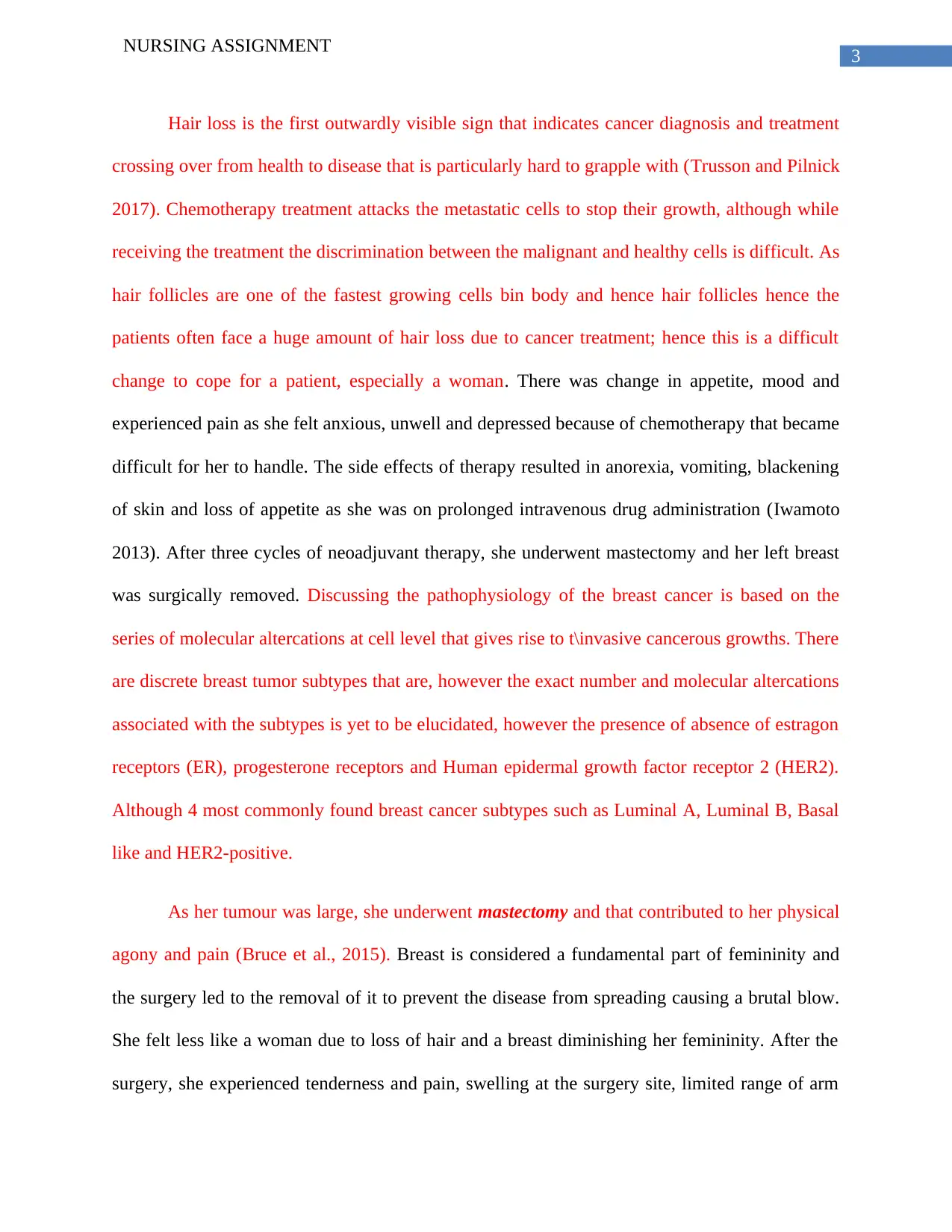
3
NURSING ASSIGNMENT
Hair loss is the first outwardly visible sign that indicates cancer diagnosis and treatment
crossing over from health to disease that is particularly hard to grapple with (Trusson and Pilnick
2017). Chemotherapy treatment attacks the metastatic cells to stop their growth, although while
receiving the treatment the discrimination between the malignant and healthy cells is difficult. As
hair follicles are one of the fastest growing cells bin body and hence hair follicles hence the
patients often face a huge amount of hair loss due to cancer treatment; hence this is a difficult
change to cope for a patient, especially a woman. There was change in appetite, mood and
experienced pain as she felt anxious, unwell and depressed because of chemotherapy that became
difficult for her to handle. The side effects of therapy resulted in anorexia, vomiting, blackening
of skin and loss of appetite as she was on prolonged intravenous drug administration (Iwamoto
2013). After three cycles of neoadjuvant therapy, she underwent mastectomy and her left breast
was surgically removed. Discussing the pathophysiology of the breast cancer is based on the
series of molecular altercations at cell level that gives rise to t\invasive cancerous growths. There
are discrete breast tumor subtypes that are, however the exact number and molecular altercations
associated with the subtypes is yet to be elucidated, however the presence of absence of estragon
receptors (ER), progesterone receptors and Human epidermal growth factor receptor 2 (HER2).
Although 4 most commonly found breast cancer subtypes such as Luminal A, Luminal B, Basal
like and HER2-positive.
As her tumour was large, she underwent mastectomy and that contributed to her physical
agony and pain (Bruce et al., 2015). Breast is considered a fundamental part of femininity and
the surgery led to the removal of it to prevent the disease from spreading causing a brutal blow.
She felt less like a woman due to loss of hair and a breast diminishing her femininity. After the
surgery, she experienced tenderness and pain, swelling at the surgery site, limited range of arm
NURSING ASSIGNMENT
Hair loss is the first outwardly visible sign that indicates cancer diagnosis and treatment
crossing over from health to disease that is particularly hard to grapple with (Trusson and Pilnick
2017). Chemotherapy treatment attacks the metastatic cells to stop their growth, although while
receiving the treatment the discrimination between the malignant and healthy cells is difficult. As
hair follicles are one of the fastest growing cells bin body and hence hair follicles hence the
patients often face a huge amount of hair loss due to cancer treatment; hence this is a difficult
change to cope for a patient, especially a woman. There was change in appetite, mood and
experienced pain as she felt anxious, unwell and depressed because of chemotherapy that became
difficult for her to handle. The side effects of therapy resulted in anorexia, vomiting, blackening
of skin and loss of appetite as she was on prolonged intravenous drug administration (Iwamoto
2013). After three cycles of neoadjuvant therapy, she underwent mastectomy and her left breast
was surgically removed. Discussing the pathophysiology of the breast cancer is based on the
series of molecular altercations at cell level that gives rise to t\invasive cancerous growths. There
are discrete breast tumor subtypes that are, however the exact number and molecular altercations
associated with the subtypes is yet to be elucidated, however the presence of absence of estragon
receptors (ER), progesterone receptors and Human epidermal growth factor receptor 2 (HER2).
Although 4 most commonly found breast cancer subtypes such as Luminal A, Luminal B, Basal
like and HER2-positive.
As her tumour was large, she underwent mastectomy and that contributed to her physical
agony and pain (Bruce et al., 2015). Breast is considered a fundamental part of femininity and
the surgery led to the removal of it to prevent the disease from spreading causing a brutal blow.
She felt less like a woman due to loss of hair and a breast diminishing her femininity. After the
surgery, she experienced tenderness and pain, swelling at the surgery site, limited range of arm
Paraphrase This Document
Need a fresh take? Get an instant paraphrase of this document with our AI Paraphraser
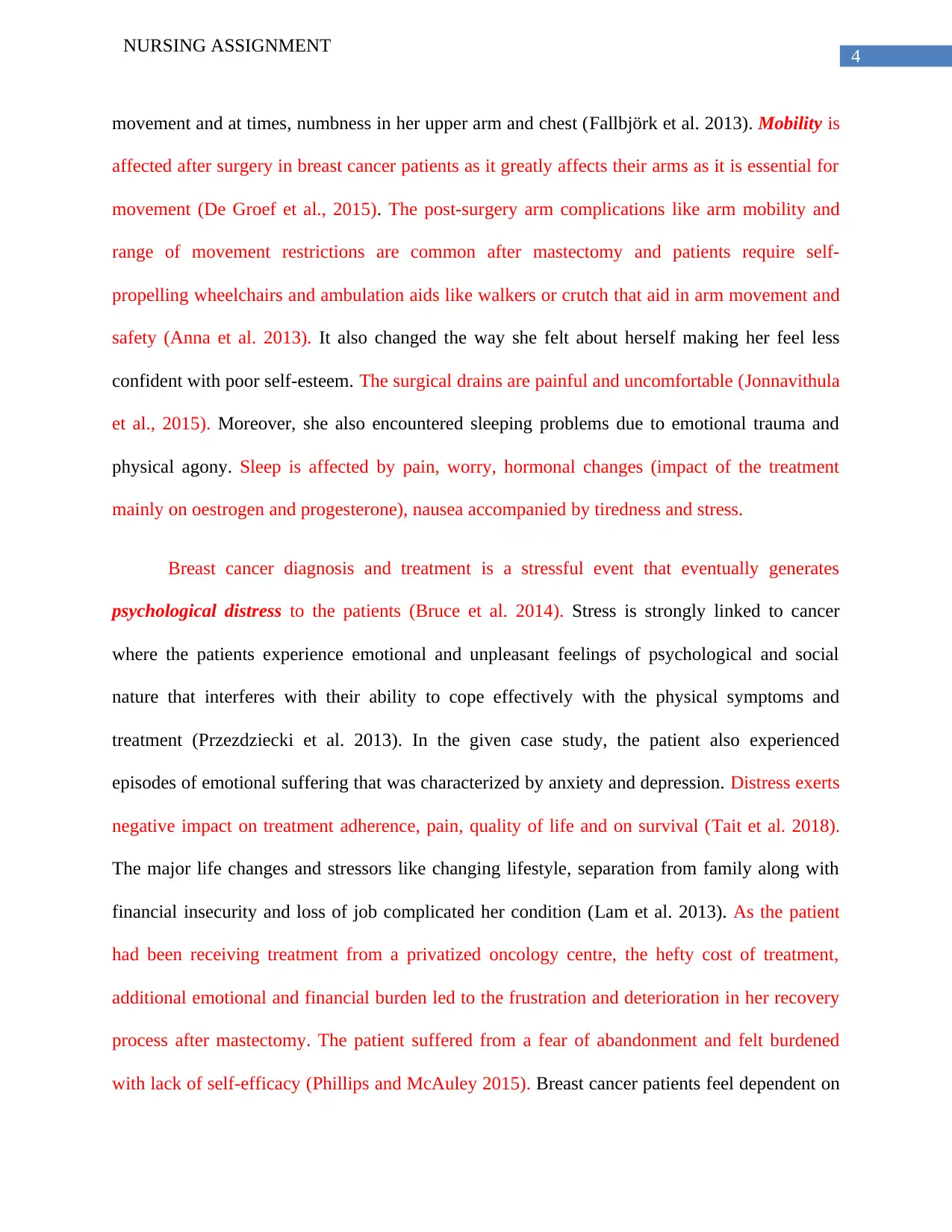
4
NURSING ASSIGNMENT
movement and at times, numbness in her upper arm and chest (Fallbjörk et al. 2013). Mobility is
affected after surgery in breast cancer patients as it greatly affects their arms as it is essential for
movement (De Groef et al., 2015). The post-surgery arm complications like arm mobility and
range of movement restrictions are common after mastectomy and patients require self-
propelling wheelchairs and ambulation aids like walkers or crutch that aid in arm movement and
safety (Anna et al. 2013). It also changed the way she felt about herself making her feel less
confident with poor self-esteem. The surgical drains are painful and uncomfortable (Jonnavithula
et al., 2015). Moreover, she also encountered sleeping problems due to emotional trauma and
physical agony. Sleep is affected by pain, worry, hormonal changes (impact of the treatment
mainly on oestrogen and progesterone), nausea accompanied by tiredness and stress.
Breast cancer diagnosis and treatment is a stressful event that eventually generates
psychological distress to the patients (Bruce et al. 2014). Stress is strongly linked to cancer
where the patients experience emotional and unpleasant feelings of psychological and social
nature that interferes with their ability to cope effectively with the physical symptoms and
treatment (Przezdziecki et al. 2013). In the given case study, the patient also experienced
episodes of emotional suffering that was characterized by anxiety and depression. Distress exerts
negative impact on treatment adherence, pain, quality of life and on survival (Tait et al. 2018).
The major life changes and stressors like changing lifestyle, separation from family along with
financial insecurity and loss of job complicated her condition (Lam et al. 2013). As the patient
had been receiving treatment from a privatized oncology centre, the hefty cost of treatment,
additional emotional and financial burden led to the frustration and deterioration in her recovery
process after mastectomy. The patient suffered from a fear of abandonment and felt burdened
with lack of self-efficacy (Phillips and McAuley 2015). Breast cancer patients feel dependent on
NURSING ASSIGNMENT
movement and at times, numbness in her upper arm and chest (Fallbjörk et al. 2013). Mobility is
affected after surgery in breast cancer patients as it greatly affects their arms as it is essential for
movement (De Groef et al., 2015). The post-surgery arm complications like arm mobility and
range of movement restrictions are common after mastectomy and patients require self-
propelling wheelchairs and ambulation aids like walkers or crutch that aid in arm movement and
safety (Anna et al. 2013). It also changed the way she felt about herself making her feel less
confident with poor self-esteem. The surgical drains are painful and uncomfortable (Jonnavithula
et al., 2015). Moreover, she also encountered sleeping problems due to emotional trauma and
physical agony. Sleep is affected by pain, worry, hormonal changes (impact of the treatment
mainly on oestrogen and progesterone), nausea accompanied by tiredness and stress.
Breast cancer diagnosis and treatment is a stressful event that eventually generates
psychological distress to the patients (Bruce et al. 2014). Stress is strongly linked to cancer
where the patients experience emotional and unpleasant feelings of psychological and social
nature that interferes with their ability to cope effectively with the physical symptoms and
treatment (Przezdziecki et al. 2013). In the given case study, the patient also experienced
episodes of emotional suffering that was characterized by anxiety and depression. Distress exerts
negative impact on treatment adherence, pain, quality of life and on survival (Tait et al. 2018).
The major life changes and stressors like changing lifestyle, separation from family along with
financial insecurity and loss of job complicated her condition (Lam et al. 2013). As the patient
had been receiving treatment from a privatized oncology centre, the hefty cost of treatment,
additional emotional and financial burden led to the frustration and deterioration in her recovery
process after mastectomy. The patient suffered from a fear of abandonment and felt burdened
with lack of self-efficacy (Phillips and McAuley 2015). Breast cancer patients feel dependent on
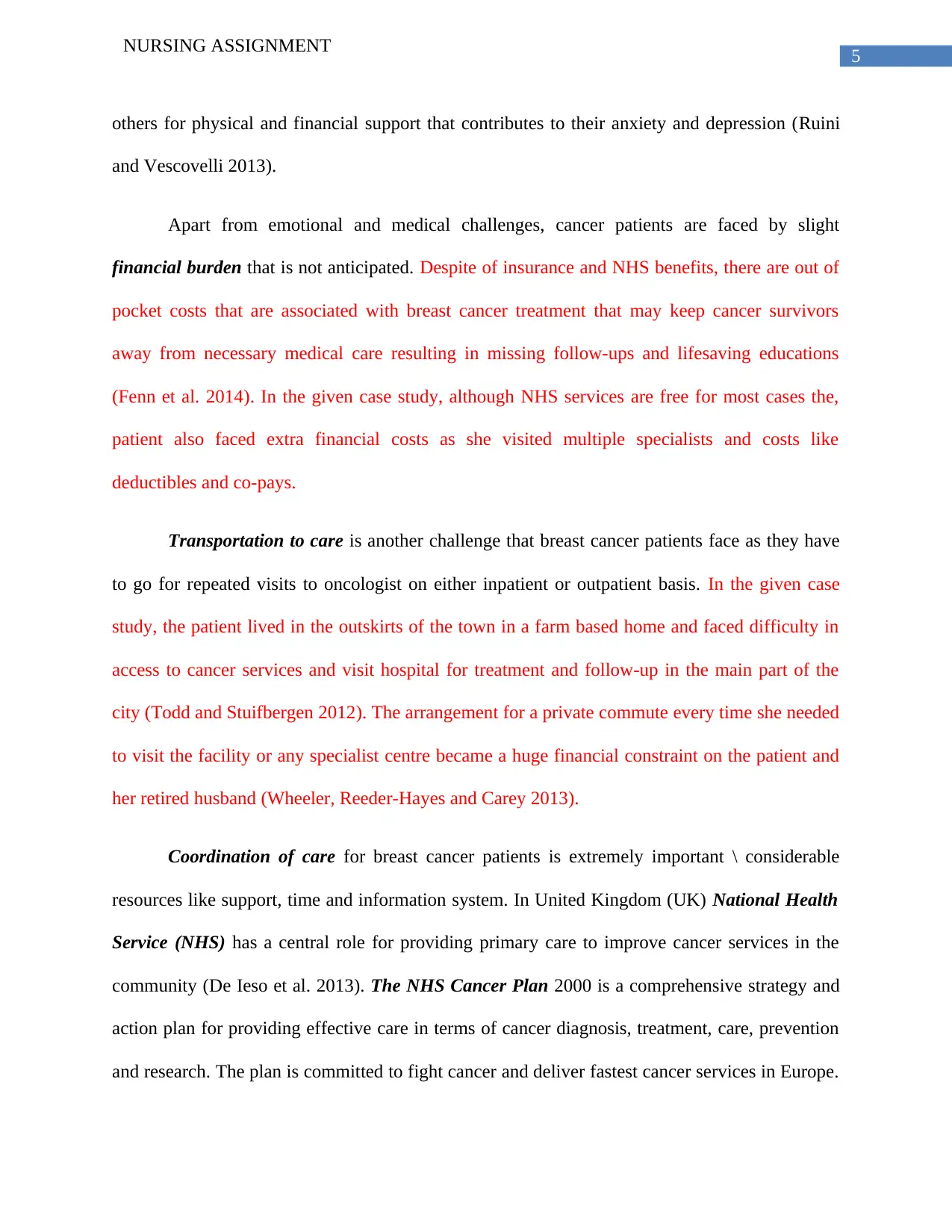
5
NURSING ASSIGNMENT
others for physical and financial support that contributes to their anxiety and depression (Ruini
and Vescovelli 2013).
Apart from emotional and medical challenges, cancer patients are faced by slight
financial burden that is not anticipated. Despite of insurance and NHS benefits, there are out of
pocket costs that are associated with breast cancer treatment that may keep cancer survivors
away from necessary medical care resulting in missing follow-ups and lifesaving educations
(Fenn et al. 2014). In the given case study, although NHS services are free for most cases the,
patient also faced extra financial costs as she visited multiple specialists and costs like
deductibles and co-pays.
Transportation to care is another challenge that breast cancer patients face as they have
to go for repeated visits to oncologist on either inpatient or outpatient basis. In the given case
study, the patient lived in the outskirts of the town in a farm based home and faced difficulty in
access to cancer services and visit hospital for treatment and follow-up in the main part of the
city (Todd and Stuifbergen 2012). The arrangement for a private commute every time she needed
to visit the facility or any specialist centre became a huge financial constraint on the patient and
her retired husband (Wheeler, Reeder-Hayes and Carey 2013).
Coordination of care for breast cancer patients is extremely important \ considerable
resources like support, time and information system. In United Kingdom (UK) National Health
Service (NHS) has a central role for providing primary care to improve cancer services in the
community (De Ieso et al. 2013). The NHS Cancer Plan 2000 is a comprehensive strategy and
action plan for providing effective care in terms of cancer diagnosis, treatment, care, prevention
and research. The plan is committed to fight cancer and deliver fastest cancer services in Europe.
NURSING ASSIGNMENT
others for physical and financial support that contributes to their anxiety and depression (Ruini
and Vescovelli 2013).
Apart from emotional and medical challenges, cancer patients are faced by slight
financial burden that is not anticipated. Despite of insurance and NHS benefits, there are out of
pocket costs that are associated with breast cancer treatment that may keep cancer survivors
away from necessary medical care resulting in missing follow-ups and lifesaving educations
(Fenn et al. 2014). In the given case study, although NHS services are free for most cases the,
patient also faced extra financial costs as she visited multiple specialists and costs like
deductibles and co-pays.
Transportation to care is another challenge that breast cancer patients face as they have
to go for repeated visits to oncologist on either inpatient or outpatient basis. In the given case
study, the patient lived in the outskirts of the town in a farm based home and faced difficulty in
access to cancer services and visit hospital for treatment and follow-up in the main part of the
city (Todd and Stuifbergen 2012). The arrangement for a private commute every time she needed
to visit the facility or any specialist centre became a huge financial constraint on the patient and
her retired husband (Wheeler, Reeder-Hayes and Carey 2013).
Coordination of care for breast cancer patients is extremely important \ considerable
resources like support, time and information system. In United Kingdom (UK) National Health
Service (NHS) has a central role for providing primary care to improve cancer services in the
community (De Ieso et al. 2013). The NHS Cancer Plan 2000 is a comprehensive strategy and
action plan for providing effective care in terms of cancer diagnosis, treatment, care, prevention
and research. The plan is committed to fight cancer and deliver fastest cancer services in Europe.
⊘ This is a preview!⊘
Do you want full access?
Subscribe today to unlock all pages.

Trusted by 1+ million students worldwide
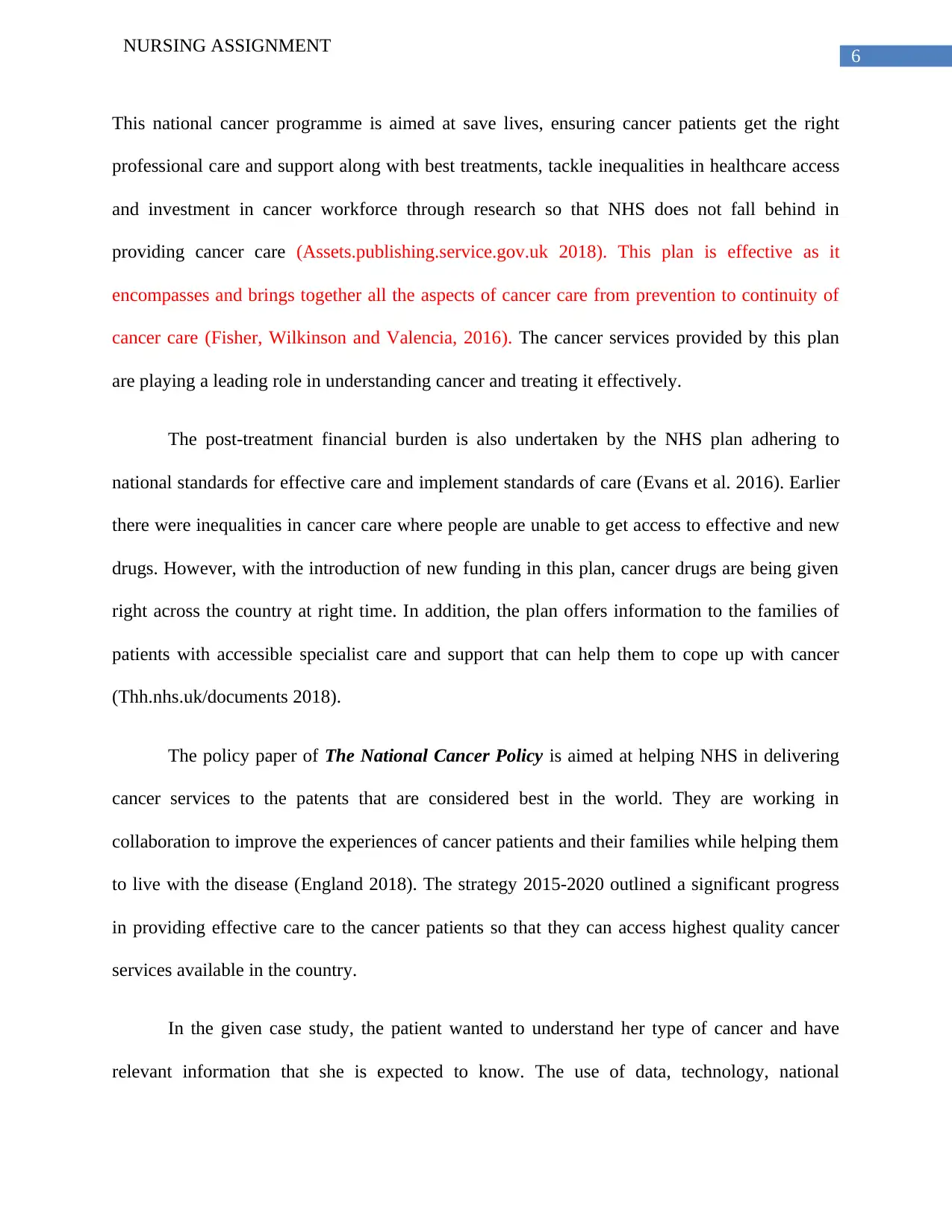
6
NURSING ASSIGNMENT
This national cancer programme is aimed at save lives, ensuring cancer patients get the right
professional care and support along with best treatments, tackle inequalities in healthcare access
and investment in cancer workforce through research so that NHS does not fall behind in
providing cancer care (Assets.publishing.service.gov.uk 2018). This plan is effective as it
encompasses and brings together all the aspects of cancer care from prevention to continuity of
cancer care (Fisher, Wilkinson and Valencia, 2016). The cancer services provided by this plan
are playing a leading role in understanding cancer and treating it effectively.
The post-treatment financial burden is also undertaken by the NHS plan adhering to
national standards for effective care and implement standards of care (Evans et al. 2016). Earlier
there were inequalities in cancer care where people are unable to get access to effective and new
drugs. However, with the introduction of new funding in this plan, cancer drugs are being given
right across the country at right time. In addition, the plan offers information to the families of
patients with accessible specialist care and support that can help them to cope up with cancer
(Thh.nhs.uk/documents 2018).
The policy paper of The National Cancer Policy is aimed at helping NHS in delivering
cancer services to the patents that are considered best in the world. They are working in
collaboration to improve the experiences of cancer patients and their families while helping them
to live with the disease (England 2018). The strategy 2015-2020 outlined a significant progress
in providing effective care to the cancer patients so that they can access highest quality cancer
services available in the country.
In the given case study, the patient wanted to understand her type of cancer and have
relevant information that she is expected to know. The use of data, technology, national
NURSING ASSIGNMENT
This national cancer programme is aimed at save lives, ensuring cancer patients get the right
professional care and support along with best treatments, tackle inequalities in healthcare access
and investment in cancer workforce through research so that NHS does not fall behind in
providing cancer care (Assets.publishing.service.gov.uk 2018). This plan is effective as it
encompasses and brings together all the aspects of cancer care from prevention to continuity of
cancer care (Fisher, Wilkinson and Valencia, 2016). The cancer services provided by this plan
are playing a leading role in understanding cancer and treating it effectively.
The post-treatment financial burden is also undertaken by the NHS plan adhering to
national standards for effective care and implement standards of care (Evans et al. 2016). Earlier
there were inequalities in cancer care where people are unable to get access to effective and new
drugs. However, with the introduction of new funding in this plan, cancer drugs are being given
right across the country at right time. In addition, the plan offers information to the families of
patients with accessible specialist care and support that can help them to cope up with cancer
(Thh.nhs.uk/documents 2018).
The policy paper of The National Cancer Policy is aimed at helping NHS in delivering
cancer services to the patents that are considered best in the world. They are working in
collaboration to improve the experiences of cancer patients and their families while helping them
to live with the disease (England 2018). The strategy 2015-2020 outlined a significant progress
in providing effective care to the cancer patients so that they can access highest quality cancer
services available in the country.
In the given case study, the patient wanted to understand her type of cancer and have
relevant information that she is expected to know. The use of data, technology, national
Paraphrase This Document
Need a fresh take? Get an instant paraphrase of this document with our AI Paraphraser

7
NURSING ASSIGNMENT
guidelines and framework helped her to avail the best possible quality cancer treatment for her
condition. She navigated the system and kept herself updated with information, follow-ups and
specialist clinic visits.
Personalized care and support planning is a new concept that brings together values of
patients, carers and communities in delivering effective, sustainable and patient-centred care for
people with life shortening or long-term illness (LTI) (Koh et al. 2013). In context to cancer care
and support, this planning is beneficial in meeting the heath needs of the patients who are
receiving treatment for cancer as they have complex needs with support from different
specialized agencies. This approach is effectively approved in local health communities where
GP services are also provided for agreed cancer care plan. There is proper coordination of care
where the 49 year old female actively participated in the plan of care while working in
collaboration with multi-disciplinary team, carers and bringing together services that helped to
achieve positive health outcomes for the patient in breast cancer care and support.
Cancer diagnosis and treatment brings with it an occasional series or constellation of
medical and psychosocial challenges that can cause a cascade of complications, stress, worries
and new needs. Fragile individuals who are suffering from LTI find them confused and
fragmented while receiving care as it is treated as a disease instead of individuals with
personal and practical needs (Tsianakas et al. 2012). In the given case study, the female could
view a dizzying array of cancer specialists and her family navigating the system and advocating
her personal wishes. The marathon of diagnostic tests, high costs of chemotherapies and
transportation to clinic were quite fragmented and required a comprehensive care system that
meets the needs of patients with LTI or life shortening illness like cancer. The journey of the
patient suffering from life limiting illness may face communication gaps, lingering inefficiencies
NURSING ASSIGNMENT
guidelines and framework helped her to avail the best possible quality cancer treatment for her
condition. She navigated the system and kept herself updated with information, follow-ups and
specialist clinic visits.
Personalized care and support planning is a new concept that brings together values of
patients, carers and communities in delivering effective, sustainable and patient-centred care for
people with life shortening or long-term illness (LTI) (Koh et al. 2013). In context to cancer care
and support, this planning is beneficial in meeting the heath needs of the patients who are
receiving treatment for cancer as they have complex needs with support from different
specialized agencies. This approach is effectively approved in local health communities where
GP services are also provided for agreed cancer care plan. There is proper coordination of care
where the 49 year old female actively participated in the plan of care while working in
collaboration with multi-disciplinary team, carers and bringing together services that helped to
achieve positive health outcomes for the patient in breast cancer care and support.
Cancer diagnosis and treatment brings with it an occasional series or constellation of
medical and psychosocial challenges that can cause a cascade of complications, stress, worries
and new needs. Fragile individuals who are suffering from LTI find them confused and
fragmented while receiving care as it is treated as a disease instead of individuals with
personal and practical needs (Tsianakas et al. 2012). In the given case study, the female could
view a dizzying array of cancer specialists and her family navigating the system and advocating
her personal wishes. The marathon of diagnostic tests, high costs of chemotherapies and
transportation to clinic were quite fragmented and required a comprehensive care system that
meets the needs of patients with LTI or life shortening illness like cancer. The journey of the
patient suffering from life limiting illness may face communication gaps, lingering inefficiencies
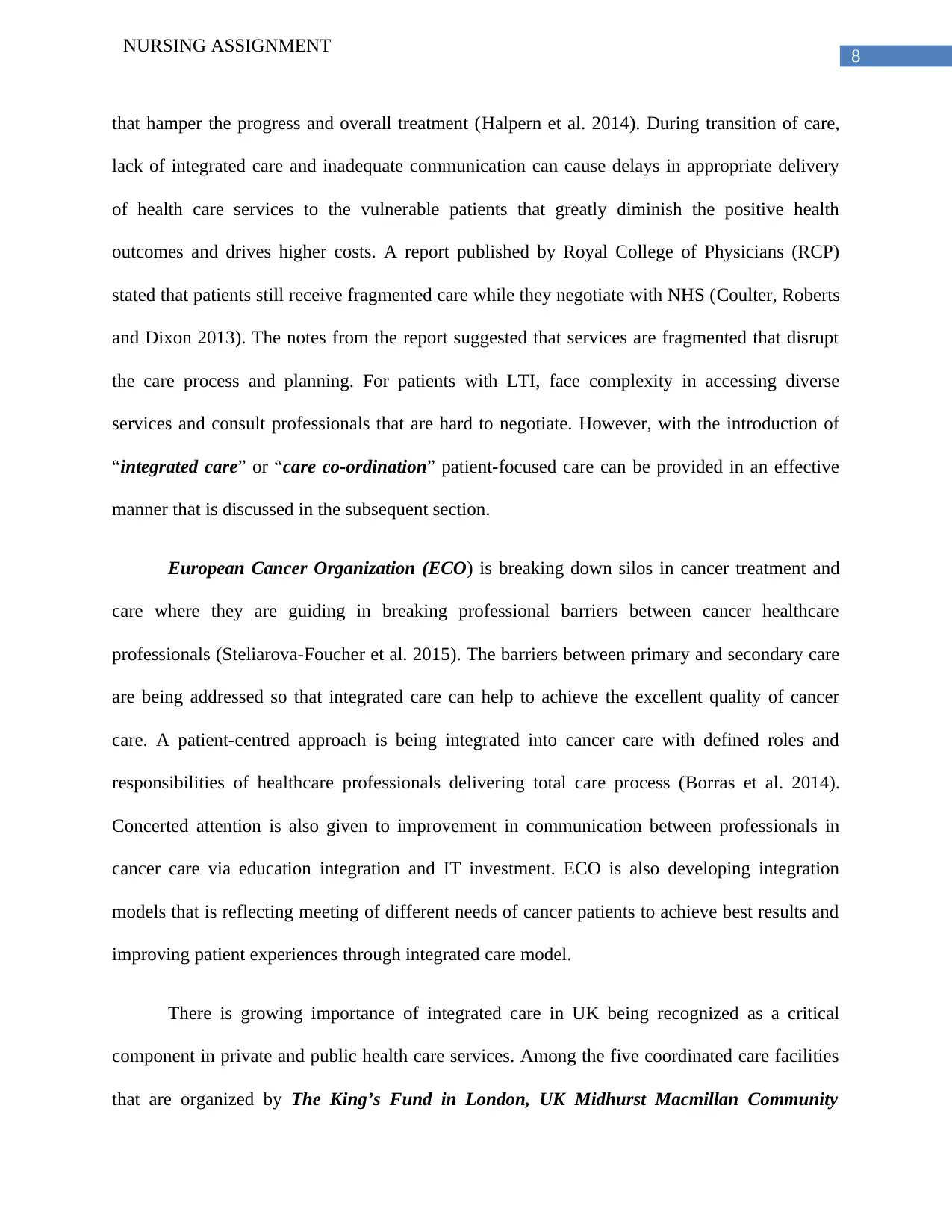
8
NURSING ASSIGNMENT
that hamper the progress and overall treatment (Halpern et al. 2014). During transition of care,
lack of integrated care and inadequate communication can cause delays in appropriate delivery
of health care services to the vulnerable patients that greatly diminish the positive health
outcomes and drives higher costs. A report published by Royal College of Physicians (RCP)
stated that patients still receive fragmented care while they negotiate with NHS (Coulter, Roberts
and Dixon 2013). The notes from the report suggested that services are fragmented that disrupt
the care process and planning. For patients with LTI, face complexity in accessing diverse
services and consult professionals that are hard to negotiate. However, with the introduction of
“integrated care” or “care co-ordination” patient-focused care can be provided in an effective
manner that is discussed in the subsequent section.
European Cancer Organization (ECO) is breaking down silos in cancer treatment and
care where they are guiding in breaking professional barriers between cancer healthcare
professionals (Steliarova-Foucher et al. 2015). The barriers between primary and secondary care
are being addressed so that integrated care can help to achieve the excellent quality of cancer
care. A patient-centred approach is being integrated into cancer care with defined roles and
responsibilities of healthcare professionals delivering total care process (Borras et al. 2014).
Concerted attention is also given to improvement in communication between professionals in
cancer care via education integration and IT investment. ECO is also developing integration
models that is reflecting meeting of different needs of cancer patients to achieve best results and
improving patient experiences through integrated care model.
There is growing importance of integrated care in UK being recognized as a critical
component in private and public health care services. Among the five coordinated care facilities
that are organized by The King’s Fund in London, UK Midhurst Macmillan Community
NURSING ASSIGNMENT
that hamper the progress and overall treatment (Halpern et al. 2014). During transition of care,
lack of integrated care and inadequate communication can cause delays in appropriate delivery
of health care services to the vulnerable patients that greatly diminish the positive health
outcomes and drives higher costs. A report published by Royal College of Physicians (RCP)
stated that patients still receive fragmented care while they negotiate with NHS (Coulter, Roberts
and Dixon 2013). The notes from the report suggested that services are fragmented that disrupt
the care process and planning. For patients with LTI, face complexity in accessing diverse
services and consult professionals that are hard to negotiate. However, with the introduction of
“integrated care” or “care co-ordination” patient-focused care can be provided in an effective
manner that is discussed in the subsequent section.
European Cancer Organization (ECO) is breaking down silos in cancer treatment and
care where they are guiding in breaking professional barriers between cancer healthcare
professionals (Steliarova-Foucher et al. 2015). The barriers between primary and secondary care
are being addressed so that integrated care can help to achieve the excellent quality of cancer
care. A patient-centred approach is being integrated into cancer care with defined roles and
responsibilities of healthcare professionals delivering total care process (Borras et al. 2014).
Concerted attention is also given to improvement in communication between professionals in
cancer care via education integration and IT investment. ECO is also developing integration
models that is reflecting meeting of different needs of cancer patients to achieve best results and
improving patient experiences through integrated care model.
There is growing importance of integrated care in UK being recognized as a critical
component in private and public health care services. Among the five coordinated care facilities
that are organized by The King’s Fund in London, UK Midhurst Macmillan Community
⊘ This is a preview!⊘
Do you want full access?
Subscribe today to unlock all pages.

Trusted by 1+ million students worldwide
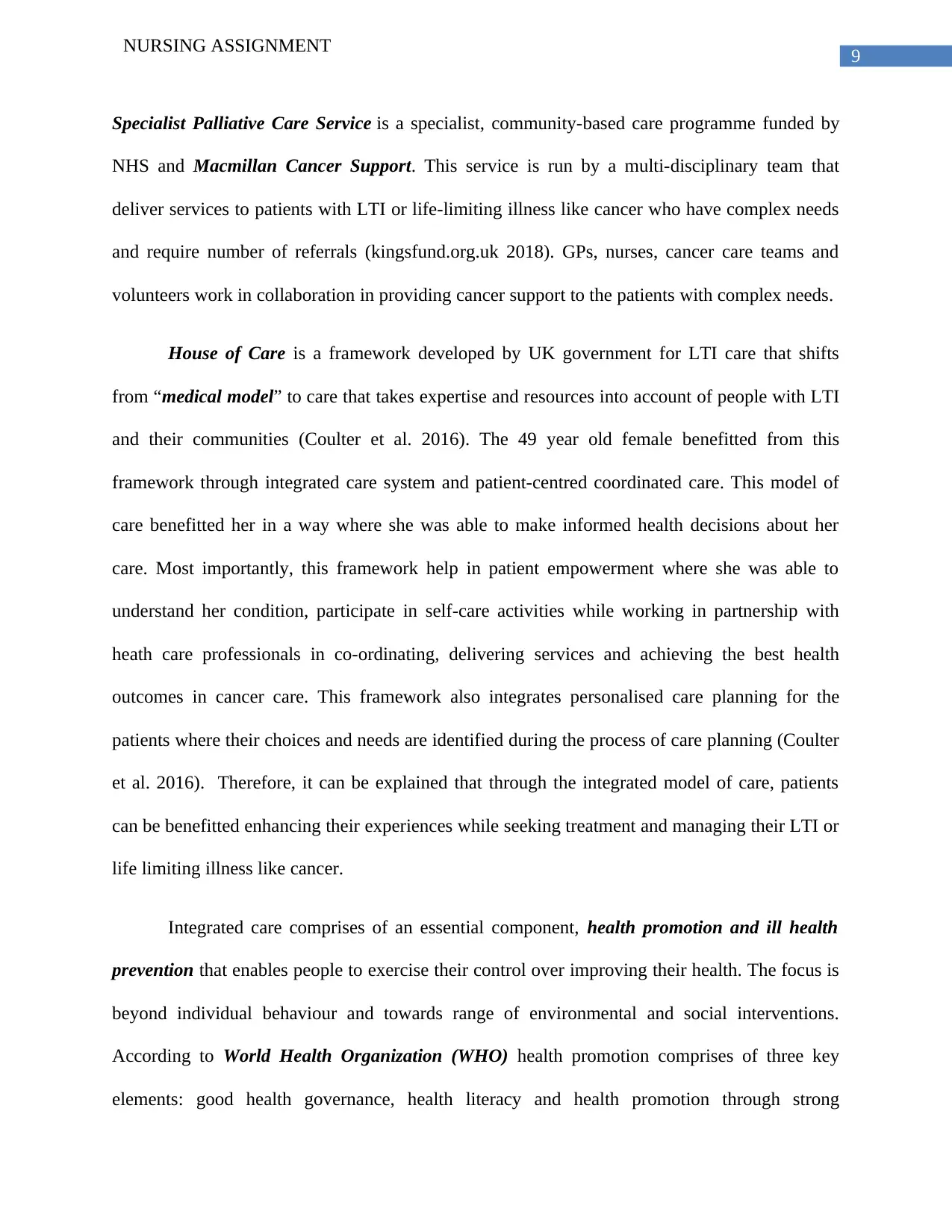
9
NURSING ASSIGNMENT
Specialist Palliative Care Service is a specialist, community-based care programme funded by
NHS and Macmillan Cancer Support. This service is run by a multi-disciplinary team that
deliver services to patients with LTI or life-limiting illness like cancer who have complex needs
and require number of referrals (kingsfund.org.uk 2018). GPs, nurses, cancer care teams and
volunteers work in collaboration in providing cancer support to the patients with complex needs.
House of Care is a framework developed by UK government for LTI care that shifts
from “medical model” to care that takes expertise and resources into account of people with LTI
and their communities (Coulter et al. 2016). The 49 year old female benefitted from this
framework through integrated care system and patient-centred coordinated care. This model of
care benefitted her in a way where she was able to make informed health decisions about her
care. Most importantly, this framework help in patient empowerment where she was able to
understand her condition, participate in self-care activities while working in partnership with
heath care professionals in co-ordinating, delivering services and achieving the best health
outcomes in cancer care. This framework also integrates personalised care planning for the
patients where their choices and needs are identified during the process of care planning (Coulter
et al. 2016). Therefore, it can be explained that through the integrated model of care, patients
can be benefitted enhancing their experiences while seeking treatment and managing their LTI or
life limiting illness like cancer.
Integrated care comprises of an essential component, health promotion and ill health
prevention that enables people to exercise their control over improving their health. The focus is
beyond individual behaviour and towards range of environmental and social interventions.
According to World Health Organization (WHO) health promotion comprises of three key
elements: good health governance, health literacy and health promotion through strong
NURSING ASSIGNMENT
Specialist Palliative Care Service is a specialist, community-based care programme funded by
NHS and Macmillan Cancer Support. This service is run by a multi-disciplinary team that
deliver services to patients with LTI or life-limiting illness like cancer who have complex needs
and require number of referrals (kingsfund.org.uk 2018). GPs, nurses, cancer care teams and
volunteers work in collaboration in providing cancer support to the patients with complex needs.
House of Care is a framework developed by UK government for LTI care that shifts
from “medical model” to care that takes expertise and resources into account of people with LTI
and their communities (Coulter et al. 2016). The 49 year old female benefitted from this
framework through integrated care system and patient-centred coordinated care. This model of
care benefitted her in a way where she was able to make informed health decisions about her
care. Most importantly, this framework help in patient empowerment where she was able to
understand her condition, participate in self-care activities while working in partnership with
heath care professionals in co-ordinating, delivering services and achieving the best health
outcomes in cancer care. This framework also integrates personalised care planning for the
patients where their choices and needs are identified during the process of care planning (Coulter
et al. 2016). Therefore, it can be explained that through the integrated model of care, patients
can be benefitted enhancing their experiences while seeking treatment and managing their LTI or
life limiting illness like cancer.
Integrated care comprises of an essential component, health promotion and ill health
prevention that enables people to exercise their control over improving their health. The focus is
beyond individual behaviour and towards range of environmental and social interventions.
According to World Health Organization (WHO) health promotion comprises of three key
elements: good health governance, health literacy and health promotion through strong
Paraphrase This Document
Need a fresh take? Get an instant paraphrase of this document with our AI Paraphraser
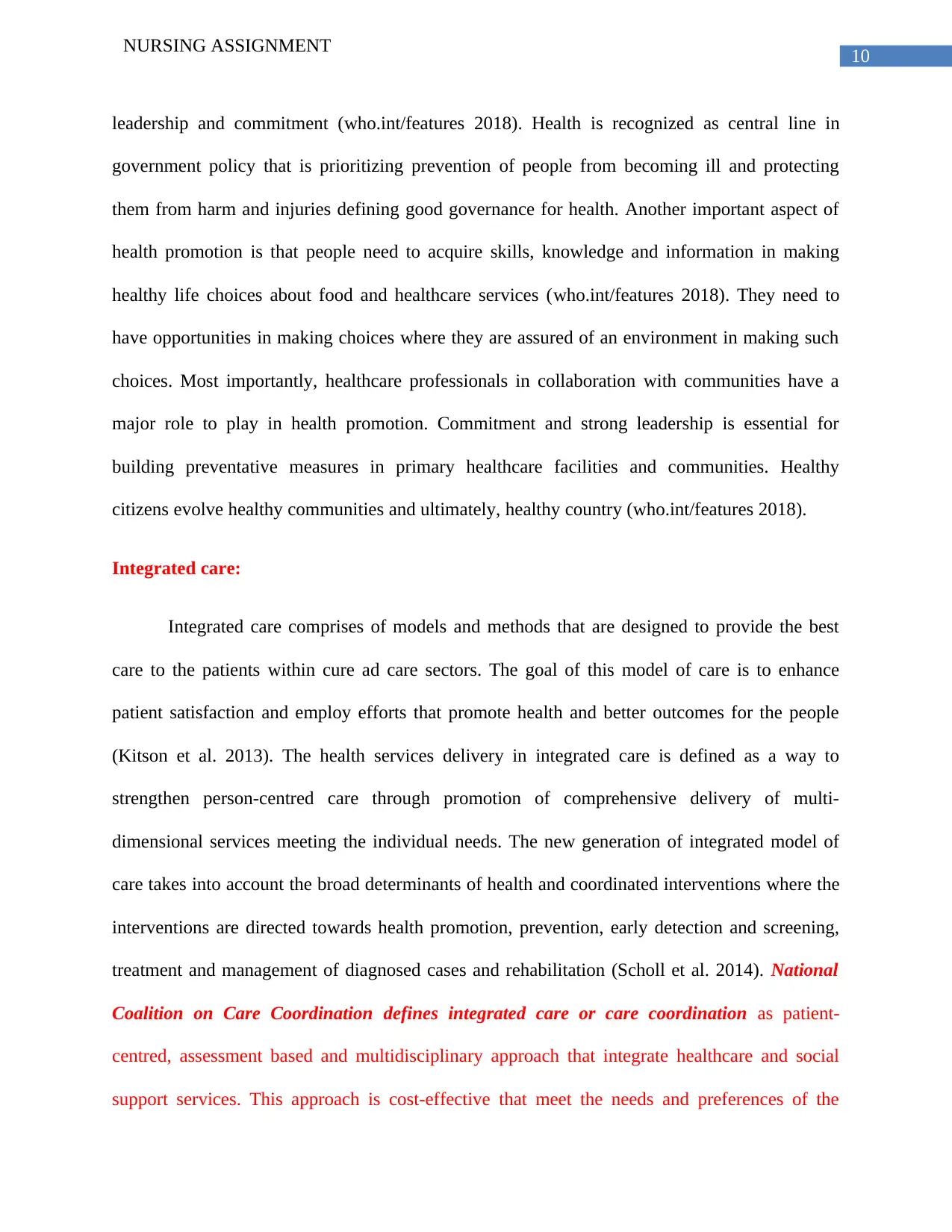
10
NURSING ASSIGNMENT
leadership and commitment (who.int/features 2018). Health is recognized as central line in
government policy that is prioritizing prevention of people from becoming ill and protecting
them from harm and injuries defining good governance for health. Another important aspect of
health promotion is that people need to acquire skills, knowledge and information in making
healthy life choices about food and healthcare services (who.int/features 2018). They need to
have opportunities in making choices where they are assured of an environment in making such
choices. Most importantly, healthcare professionals in collaboration with communities have a
major role to play in health promotion. Commitment and strong leadership is essential for
building preventative measures in primary healthcare facilities and communities. Healthy
citizens evolve healthy communities and ultimately, healthy country (who.int/features 2018).
Integrated care:
Integrated care comprises of models and methods that are designed to provide the best
care to the patients within cure ad care sectors. The goal of this model of care is to enhance
patient satisfaction and employ efforts that promote health and better outcomes for the people
(Kitson et al. 2013). The health services delivery in integrated care is defined as a way to
strengthen person-centred care through promotion of comprehensive delivery of multi-
dimensional services meeting the individual needs. The new generation of integrated model of
care takes into account the broad determinants of health and coordinated interventions where the
interventions are directed towards health promotion, prevention, early detection and screening,
treatment and management of diagnosed cases and rehabilitation (Scholl et al. 2014). National
Coalition on Care Coordination defines integrated care or care coordination as patient-
centred, assessment based and multidisciplinary approach that integrate healthcare and social
support services. This approach is cost-effective that meet the needs and preferences of the
NURSING ASSIGNMENT
leadership and commitment (who.int/features 2018). Health is recognized as central line in
government policy that is prioritizing prevention of people from becoming ill and protecting
them from harm and injuries defining good governance for health. Another important aspect of
health promotion is that people need to acquire skills, knowledge and information in making
healthy life choices about food and healthcare services (who.int/features 2018). They need to
have opportunities in making choices where they are assured of an environment in making such
choices. Most importantly, healthcare professionals in collaboration with communities have a
major role to play in health promotion. Commitment and strong leadership is essential for
building preventative measures in primary healthcare facilities and communities. Healthy
citizens evolve healthy communities and ultimately, healthy country (who.int/features 2018).
Integrated care:
Integrated care comprises of models and methods that are designed to provide the best
care to the patients within cure ad care sectors. The goal of this model of care is to enhance
patient satisfaction and employ efforts that promote health and better outcomes for the people
(Kitson et al. 2013). The health services delivery in integrated care is defined as a way to
strengthen person-centred care through promotion of comprehensive delivery of multi-
dimensional services meeting the individual needs. The new generation of integrated model of
care takes into account the broad determinants of health and coordinated interventions where the
interventions are directed towards health promotion, prevention, early detection and screening,
treatment and management of diagnosed cases and rehabilitation (Scholl et al. 2014). National
Coalition on Care Coordination defines integrated care or care coordination as patient-
centred, assessment based and multidisciplinary approach that integrate healthcare and social
support services. This approach is cost-effective that meet the needs and preferences of the
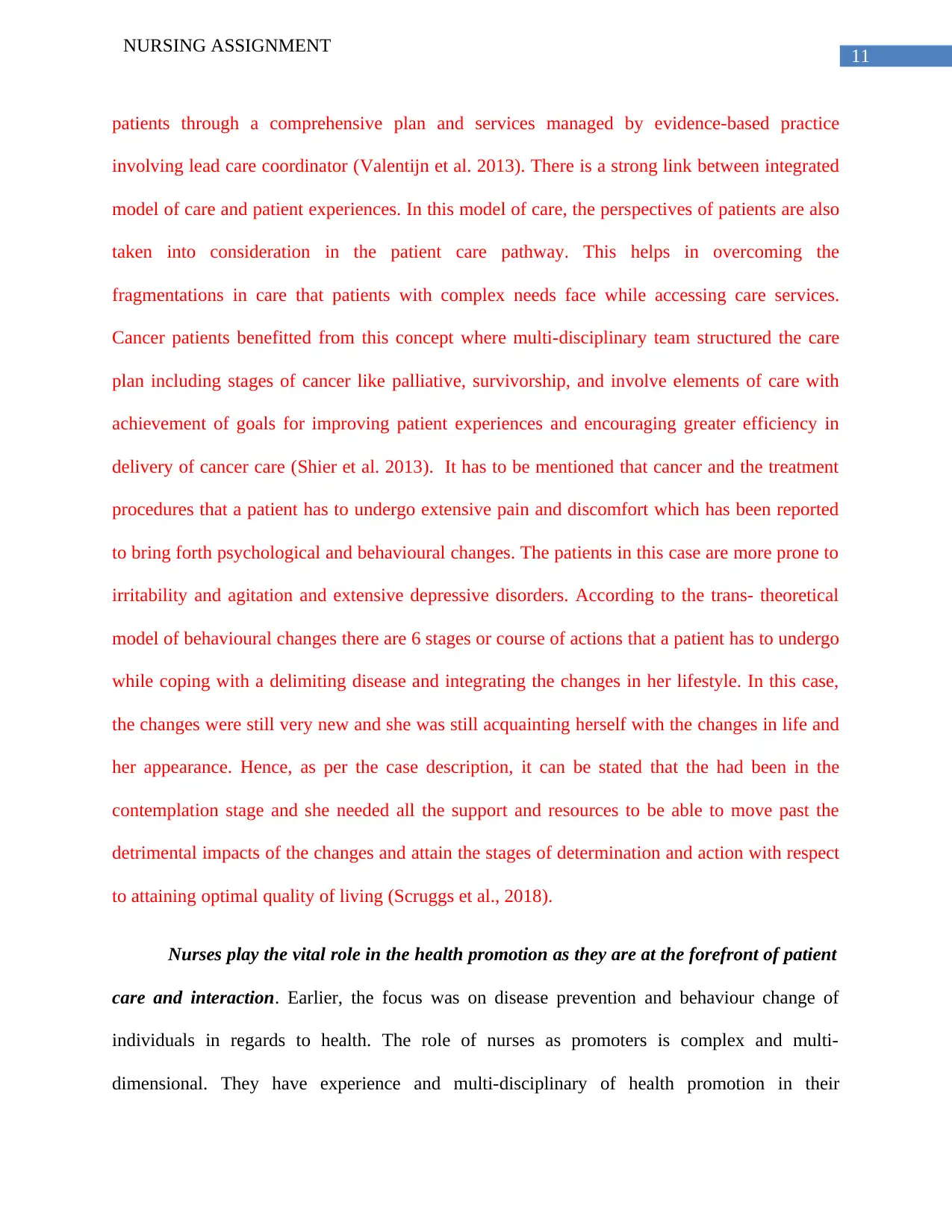
11
NURSING ASSIGNMENT
patients through a comprehensive plan and services managed by evidence-based practice
involving lead care coordinator (Valentijn et al. 2013). There is a strong link between integrated
model of care and patient experiences. In this model of care, the perspectives of patients are also
taken into consideration in the patient care pathway. This helps in overcoming the
fragmentations in care that patients with complex needs face while accessing care services.
Cancer patients benefitted from this concept where multi-disciplinary team structured the care
plan including stages of cancer like palliative, survivorship, and involve elements of care with
achievement of goals for improving patient experiences and encouraging greater efficiency in
delivery of cancer care (Shier et al. 2013). It has to be mentioned that cancer and the treatment
procedures that a patient has to undergo extensive pain and discomfort which has been reported
to bring forth psychological and behavioural changes. The patients in this case are more prone to
irritability and agitation and extensive depressive disorders. According to the trans- theoretical
model of behavioural changes there are 6 stages or course of actions that a patient has to undergo
while coping with a delimiting disease and integrating the changes in her lifestyle. In this case,
the changes were still very new and she was still acquainting herself with the changes in life and
her appearance. Hence, as per the case description, it can be stated that the had been in the
contemplation stage and she needed all the support and resources to be able to move past the
detrimental impacts of the changes and attain the stages of determination and action with respect
to attaining optimal quality of living (Scruggs et al., 2018).
Nurses play the vital role in the health promotion as they are at the forefront of patient
care and interaction. Earlier, the focus was on disease prevention and behaviour change of
individuals in regards to health. The role of nurses as promoters is complex and multi-
dimensional. They have experience and multi-disciplinary of health promotion in their
NURSING ASSIGNMENT
patients through a comprehensive plan and services managed by evidence-based practice
involving lead care coordinator (Valentijn et al. 2013). There is a strong link between integrated
model of care and patient experiences. In this model of care, the perspectives of patients are also
taken into consideration in the patient care pathway. This helps in overcoming the
fragmentations in care that patients with complex needs face while accessing care services.
Cancer patients benefitted from this concept where multi-disciplinary team structured the care
plan including stages of cancer like palliative, survivorship, and involve elements of care with
achievement of goals for improving patient experiences and encouraging greater efficiency in
delivery of cancer care (Shier et al. 2013). It has to be mentioned that cancer and the treatment
procedures that a patient has to undergo extensive pain and discomfort which has been reported
to bring forth psychological and behavioural changes. The patients in this case are more prone to
irritability and agitation and extensive depressive disorders. According to the trans- theoretical
model of behavioural changes there are 6 stages or course of actions that a patient has to undergo
while coping with a delimiting disease and integrating the changes in her lifestyle. In this case,
the changes were still very new and she was still acquainting herself with the changes in life and
her appearance. Hence, as per the case description, it can be stated that the had been in the
contemplation stage and she needed all the support and resources to be able to move past the
detrimental impacts of the changes and attain the stages of determination and action with respect
to attaining optimal quality of living (Scruggs et al., 2018).
Nurses play the vital role in the health promotion as they are at the forefront of patient
care and interaction. Earlier, the focus was on disease prevention and behaviour change of
individuals in regards to health. The role of nurses as promoters is complex and multi-
dimensional. They have experience and multi-disciplinary of health promotion in their
⊘ This is a preview!⊘
Do you want full access?
Subscribe today to unlock all pages.

Trusted by 1+ million students worldwide
1 out of 24
Related Documents
Your All-in-One AI-Powered Toolkit for Academic Success.
+13062052269
info@desklib.com
Available 24*7 on WhatsApp / Email
![[object Object]](/_next/static/media/star-bottom.7253800d.svg)
Unlock your academic potential
Copyright © 2020–2026 A2Z Services. All Rights Reserved. Developed and managed by ZUCOL.




